How to make speakers
How to make speakers
If you want to sit at home and enjoy beautiful music, you need to have the most basic audio equipment. For example, a cassette recorder or CD player as the signal source, an audio power amplifier and a pair of speakers, as well as audio signal cables and speaker cables, can form the most basic audio equipment. Among audio equipment, there are CD players and power amplifiers with complex structures, as well as speakers with uncomplicated structures. But among the audio equipment, the one with the most personality and the biggest impact on replaying music is the seemingly simple speaker. So for the replay sound of the speakers, there are so-called "British sound", "American sound", "German sound", "Japanese sound", and there are thousands of yuan and tens of thousands of yuan. Even a pair of speakers of one million yuan.
For music lovers who are not economically ample and audio lovers who want to have fun and real knowledge from their own hands, the most convenient home-made audio equipment is the speaker. As long as you know some regular things in speaker design and production, you can still make a pair of speakers that satisfy yourself. In the process of speaker production and debugging, the following problems need to be noted.
1. Choose the speaker unit
The speaker unit, commonly known as the horn, is a key part of the speaker's ability to emit sound. Only with the help of a speaker unit can people convert the audio electrical signals from CD players and power amplifiers into audible sound signals.
The speaker unit is generally divided into three categories: treble, midrange and bass. Basically belong to the scope of work of each department. For the production of excellent small-caliber woofer (generally refers to the woofer's speaker diameter is less than 6.5 inches), they can generally take into account the role of midrange speakers; and a well-designed tweeter with sufficient power , You can also take into account the role of some midrange speakers. Therefore, in the case of small bookshelf or floor-standing speakers, it is very common to use only two speaker units with one high and two low. Now let's talk specifically about the choice of speaker unit.
1 . How to choose tweeter
As the name suggests, the tweeter is a speaker unit for reproducing high-frequency sound. The structure of the tweeter mainly includes horn type, cone type, dome type and aluminum band type.
Due to the strong directivity of the horn-type tweeter, powerful treble can be heard on the front of the horn, which is mostly used for high-power sound reinforcement, conference speakers and a small number of monitor speakers.
The cone type tweeter is too large and heavy, and its high-frequency characteristics are not as good as other types of tweeters. Therefore, it is more common on old speakers and has been gradually eliminated in recent years.
The dome tweeter is currently the most commonly used tweeter in home speakers and small monitor speakers.
The dome tweeter is divided from the dome structure and can be divided into a dome unit and an anti-ball unit.
The dome tweeter is divided from the dome material, and is divided into two categories: hard dome and soft dome.
There are several types of diaphragm materials for hard dome tweeters: aluminum alloy, titanium alloy, titanium alloy composite membrane, glass membrane, diamond membrane and so on. The treble reproduced by the hard dome tweeter has a bright tone and a metallic feel. Suitable for playing popular music, movie music and effect music. Processing and making excellent aluminum alloy film, titanium alloy composite film dome tweeter, can also better express classical music and vocals.
There are several kinds of diaphragm materials for soft dome tweeters, such as silk membrane, silk membrane, rubber membrane and bulletproof cloth membrane. The treble of the soft dome tweeter when replaying music is smart and relaxed, and has a very good natural expression. It is especially handy when performing classical music, vocals and other music with standard listening concepts. It is an ideal choice for manufacturing medium and high-end home speakers and small monitor speakers. Especially in recent years, the upper limit frequency of the replay of the silk film and silk film dome has reached 40,000 Hz. In theory, the upper limit frequency of the tweeter should be at least 20000Hz, the higher the better. But the unit with excellent high-frequency upper limit is more expensive.
The dome tweeter is playing music. The horizontal diffusion angle is larger; when the anti-dome tweeter plays music, the horizontal radiation angle is small, but the sound is pure and the power is also large. The ribbon tweeter is a kind of tweeter with a long history and a long history. Only because of its structural factors, it is not an easy thing to really make its high-frequency upper limit frequency high enough and the power large enough, so it is not easy to popularize.
The upper grade of the aluminum band tweeter has an upper limit frequency of more than 30000Hz, and the withstand power currently exceeds 150W. If you are a classical music lover and have strict requirements on the timbre during replay, you may wish to choose soft dome tweeters such as silk film.
If your speakers still need to take care of karaoke and play movies, it is better to choose a hard dome unit. Of course, this is not absolute, because the replay sound of the speaker is not only related to the selected unit, but also related to the design of the crossover and the production of the cabinet.
2 . Structure of midrange unit
The midrange unit generally only has two types: cone and dome. It's just that its size and power are larger than the tweeter and it is more suitable for playing audio. The diaphragm of the midrange unit is mainly made of soft materials such as paper cones and silk membranes, and occasionally there are a small amount of alloy dome diaphragms.
3. How to choose a woofer
The structure of the woofer is mostly cone type, and a small amount is flat type.
There are many types of woofer diaphragms, such as aluminum alloy diaphragm, aluminum magnesium alloy diaphragm, ceramic diaphragm, carbon fiber diaphragm, bulletproof cloth diaphragm, glass fiber diaphragm, acrylic diaphragm, paper diaphragm, etc.
Paper diaphragm is also called speaker cone. There are many types of paper diaphragms, including paper cones, compact paper cones, paper-based wool cones, and reinforced paper cones. Bass units using aluminum alloy and aluminum-magnesium alloy diaphragms are generally smaller in caliber and bear more power, while bass units using reinforced paper cones and fiberglass diaphragms are more accurate when replaying music, and the overall flat density is good.
When selecting a speaker unit, the withstand power of the tweeter is generally not less than one-tenth of the woofer; if it is a speaker made with two-way frequency division and two units, the withstand power of the tweeter is even higher.
When making a three-way speaker, it is enough that the mid-range unit can withstand a third of the bass speaker.
When selecting a speaker unit, it is best to select the same impedance. Common low-impedance speaker units are generally divided into 4Ω and 8Ω. When selecting the speaker unit, it is also necessary to choose the same sensitivity level, generally 86dBW · m is the medium sensitivity. Those lower than 84d B are called low-sensitivity speakers, and those higher than 90dB are called high-sensitivity speakers.
If the impedance and sensitivity are too different when selecting a speaker unit, you will encounter the problems of poor design of the crossover and the imbalance of sound pressure in each frequency band when making the speaker.
Of course, when making two-way speakers, the lower limit frequency of the tweeter is lower than 2kHz, and the upper limit frequency of the woofer is higher than 4kHz, which will bring a lot of convenience when adjusting the speaker.
Second, the selection and production of frequency divider
After you have selected the speaker unit, it is then necessary to select and make the crossover. The frequency divider is divided into two general categories of frequency divider and electronic frequency divider.
Electronic frequency divider is the tiny audio signal transmitted from the signal source directly into the electronic frequency divider. The electronic frequency division divides the signal of the full frequency band (from bass to treble) into treble and bass signals, and transmits them to the corresponding power amplifier for amplification, and then pushes the corresponding speaker unit to emit sound. See Figure 1. Electronic crossover is a relatively complicated music replay system with good replay effect. In addition to the frequency divider, the electronic two-way system also requires 4 channels of audio power amplifier. The electronic three-way system requires a 6-channel power amplifier, while the electronic four-way system requires 8 independent channel power amplifiers. The advantage of electronic frequency division is that the replay sound is good, and the adjustment of the balance between each frequency band is simple and easy, but the production cost is higher.
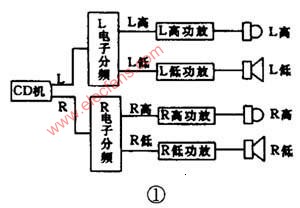
For home-made speakers, the use of traditional power divider is relatively simple, see Figure 2. As can be seen from the figure, the traditional power divider can only be composed of 5 components such as L1, C1, L2, C2 and the treble attenuation resistor R. L1 and C1 form a low-pass filter. Through its role, only the low-frequency part of the audio signal is reserved to drive the woofer unit. L2 and C2 form a high-pass filter, and only retain the high-frequency part of the audio signal to drive the tweeter. Ordinary two-frequency divider can also use a frequency division method of an inductor and a capacitor and a more complex frequency division method than FIG. 2. Each of these different frequency division methods has advantages and disadvantages. But the starting point of this article is still based on the most common figure 2.
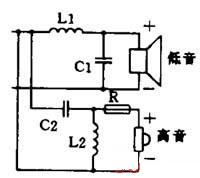
We list the values ​​of inductance and capacitance at different speaker impedances and different crossover frequencies in the attached table.
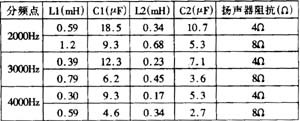
Why list such a large number of values? This has its truth. As long as your speaker unit is good enough, the design and processing of the speaker are reasonable and the debugging is accurate. No matter whether the crossover frequency is 2000Hz, 3000Hz or 4000Hz, a flat and qualified test curve can be obtained; but when listening subjectively, it is different The replay tone of the crossover speakers is very different from the music performance. Speakers with a high crossover frequency have brighter high frequencies, but the overall sound is thinner; speakers with a lower crossover frequency have a more generous and natural replay sound. Of course, all this is carried out within a certain range. If the crossover point is shifted too much, it will cause poor connection between the high and low frequencies due to the limitation of the speaker unit's own bandwidth.
There is such a rule, that is, the lower the crossover point is selected, the larger the value of the inductance and capacitance used by the crossover, and the higher the production cost. Therefore, some not-so-responsible manufacturers choose the crossover point of the product very high, which cannot guarantee the sound performance of the speaker during replay.
Although the common frequency divider has a simple structure, it also has its characteristics in terms of production.
1 . How to choose inductance coil
The inductance coil used in the frequency divider is divided into two types of air core coil and iron core coil; and the iron core coil is divided into two types of true iron core and ferrite core.
In the frequency divider, the effect of the air-core coil is the best, but it is also the largest in volume and the highest in manufacturing cost. The advantage of the air-core coil is that it is low and less affected by the magnetic field of the speaker. When choosing an air-core inductor coil, the main consideration should be the selection of the wire diameter of the inductor coil. The selected enameled wire must be able to carry the corresponding power current. If the wire diameter used is too thin, the inductor coil is easily overheated and burned when working under high power. The selected wire diameter can be calculated as long as there is enough or some margin. Blindly increasing the wire diameter, the cost is too high, and the processing is more difficult.
The iron core coil and the magnetic core coil (ferrite coil) can reduce the volume of the coil and reduce the manufacturing cost. However, due to the intervention of the magnetizer, distortion due to magnetic saturation will be introduced. At the same time, it will also be affected by the magnetic field of the speaker unit. Causes an offset of the crossover point.
When choosing an iron core coil, the power of the iron core itself is a key. Through a large number of experiments, it is confirmed that the power of the iron core coil can only work normally with low distortion when it reaches or exceeds more than 50% of the maximum power of the woofer.
Due to the hysteresis of the core material, the core coil makes the replay sound sweet, but the transient characteristics are also reduced.
In recent years, power dividers, which are slightly better, basically use air-core coils.
The cost of winding the air-core coil with round enameled wire is the lowest. The cost of using stranded wire, hexagonal wire, and ribbon wire is much more expensive. At present, there are many varieties of oxygen-free copper enameled wire. After use, the replay sound will be improved.
2 . How to choose crossover capacitor
In the frequency divider, there are many types of capacitors. There are everything from the most common electrolytic capacitors, non-inductive capacitors, audio frequency special capacitors, polyester, polystyrene, polypropylene capacitors. However, the price of these capacitors is also higher than that of some. Some individual brand-name capacitors are sold at a high price.
The use of brand-name capacitors, of course, has the advantages of accurate capacitance, stable performance, good replay sound and so on. But for home-made speakers around mid-range, the cost of choosing a capacitor of one hundred yuan is somewhat high.
When selecting the frequency-division capacitor, the low-frequency channel can use high-precision, high-quality electrolytic capacitors connected in reverse series, or a small polystyrene and polypropylene capacitor at both ends. This works well, and the price is very economical. As for high-frequency capacitors, due to the small capacity and relatively low price, it is no problem to choose a good one.

For the selection of high-frequency attenuation resistors, the main concern is the power of the resistor itself. Used in high-power speakers, the power of the attenuation resistor is relatively larger; used in low-power speakers, the power of the resistor can also be reduced. Otherwise, it will cause a mismatch between big heads and small bodies.
In short, when selecting the components of the frequency divider, it is the most economical and reasonable to have a clear purpose and tailored.
3. Box processing
In the production process of speakers, the processing of speaker cabinets is a crucial part.
In the box processing, the most important thing is only two points. One is that the box processing accuracy is higher; the second is that the box material is selected accurately. Among the materials used to make the speaker box, there are high-grade logs; high-strength multilayer boards; synthetic materials; and organic glass and stone. The so-called high-grade logs not only refer to the high-grade and precious wood itself, but the most important thing is that the wood itself undergoes years of drying and aging treatment. Only in this way can we ensure that the manufactured box will not crack or deform.
After many years of practice, the materials used to make the speaker box are the best sound with multilayer boards and high-quality logs of sufficient thickness, but the price is also the most expensive. The overall feel of the plexiglass cabinet is also good; MDF is the most affordable material for making speaker cabinets.
In the processing of the speaker box, there are the following methods:
1 . The bending method is shown in Figure 4. In this method, a V-shaped groove is formed on a long medium-density board pasted with PVC fabric, which is then bent and glued to form a speaker box. This method is mostly used in the production of large-volume speakers.
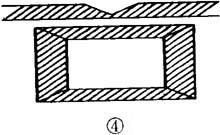
2 . See figure 5 for the inlay reinforcement method. In the self-made speaker, cut the sheet according to the drawings, and then add glued wooden strips at the interface of the sheet to strengthen and combine. This method is suitable for hand-made speakers.

3. The assembly method is shown in Figure 6. This is a new process for making speakers. There are 45 ° + 90 ° slopes and gaps around the speaker board with precision machining machinery. In the case of hand-made speaker box, you can use the self-positioning effect of the 90 ° notch of the speaker plate and the long inclined surface of 45 °. As long as enough adhesive is applied to the interface, it is tied with a rope after assembly. After the glue is dried, that is The speaker box with high processing precision and strong and beautiful appearance can be obtained.
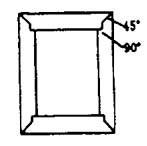
After the speaker cabinet is finished, as long as the surface of the cabinet is painted, decorated with wood veneer, you are done.
4. Assembly and debugging of self-made speakers
In the assembly and debugging of self-made speakers, there are several issues that need to be noted:
First, the connection between the crossover and the speaker unit +,-must not be wrong. If the connection is wrong, the sound of the speaker cannot be adjusted well.
Second, when installing the speaker unit, the tightness of each fixing screw should be consistent. Otherwise, when the speaker is working, it is easy to produce unexpected resonance.
The third is that the length of the inverter tube and the amount of sound-absorbing material in the box should be appropriate, otherwise it will affect the performance of the replayed music. Especially the length of the inverter tube will have a direct impact on the low end of the test frequency response of the speaker.
The above parts must be adjusted many times and carefully. Making speakers yourself is a process of practice and long knowledge.
Through his hard work, he has harvested the speakers and increased his talents in the production of speakers. He can also save part of the money to buy finished speakers and use them for other purposes, so it is a good thing with multiple incomes and the production process is also simple , Everyone can learn to make.
Ultra Light less than 8kg for each LED panel.
Low Cost of Splicing
Standard 16:9 LED panel can also precisely achieve HD/FHD/UHD/SHV resolution just right, and with a 27" diagonal panel size it can become a perfect substitute for any existing 54" or 108" LCD screen.
Convenient Front/Rear Installation and Maintenance
The install procedure is as quick as block-building. It supports for both front and rear installation with a panel thickness of only 100mm. Additionally, module, power supply, receiving card, conversion card and cables between panels can all be maintained quickly from the front without professional skills.
Intelligent System
Calibration data retrieval function and worry-free parameter back-up function are both embedded in every smart LED Module. Besides, power system, temperature and other working status are automatically monitored to achieve intelligent management.
Less Is More
Led Module, conversion card, and receiving card between panels are connected all through one connector of high stability. Thus, the panel presents a contracted and concise design style with no external cables.
Perfect Display Effect
160° ultra wide horizontal and vertical viewing angle covers more potential customers.
The broadcasting pictures are stable with no scanning line, and the edge of image is sharp and clear when dealing with dynamic pictures.
Stable Operation
JoyLED AC-DC and DC-DC power schemes are both available to ensure a safe and reliable operation of the LED screen. No sudden shut-down will occur during use.
Safe Operation
With hot double backup for Signal, stable broadcasting would be guaranteed when failure happens.
Anti-hacking Encryption could avoid malicious signal cut-off and input.
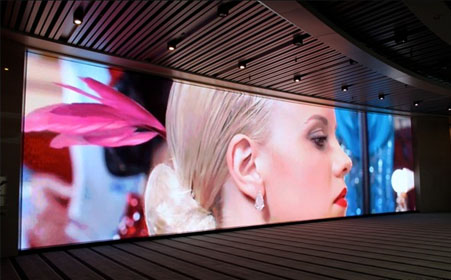
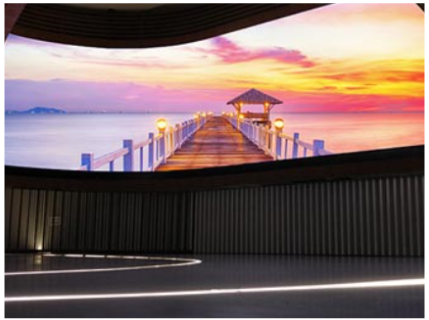
Fine Pitch Led Display,Led Digital Display,Outdoor Led Screen,Led Screen Display
Shenzhen Joy LED Display Co., Ltd. , https://www.joe-led.com